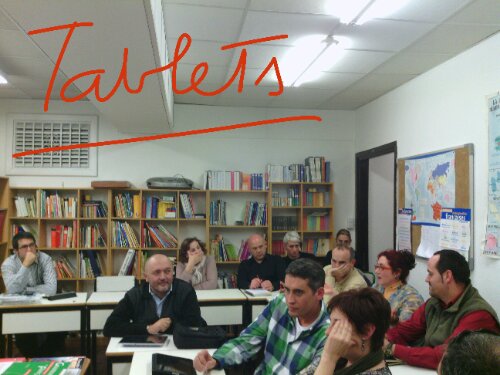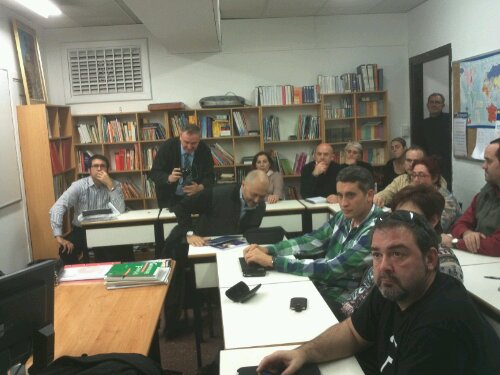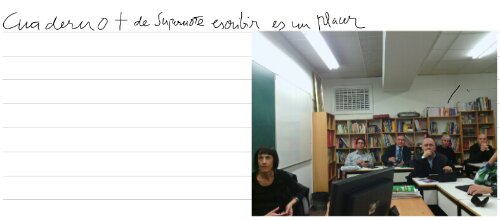
Picture: web.cortland.edu/flteach/methods/obj2/cuseeme2.html
When I review an old article, was 1997 when I’ve published it in Basque and 1999 in English, there are usually obsolete links (websites are not forever) and Internet related tools, of course, but sometimes you discover that most of the content is correct and useful.
Tis is the case of the article I show you below.
Introduction
Salaberry (Salaberry, 1996: 23) raises an interesting question about communication by means of the computer. Quoting other writers, he reminds us that the «negotiation of meaning» that occurs in normal conversations is the key to the learning process for a second or third language. However, groupwork and pairwork are fundamental to increasing student practice in the classroom. Groupwork creates an exchange of information by involving the student in the interaction. This type of interaction is essential for target language acquisition and it is clear that Computer Mediated Communication (CMC) is helpful in creating linguistic interaction. But, and this is the question here, is the environment created by the computer the right one to create interaction in the aforementioned pedagogical conditions?
According to Salaberry, the computer increases the effectiveness with which a task is carried out. CMC offers the language teacher a tool with an excellent price/quality relationship to create different types of interaction between students.
Ideal Conditions for Learning a Second Language
Quoting the work of Long and Pica, Chapelle (Chapelle, 1998) says that seven ideal hypotheses can be established for the learning of a second language. We shall only mention some of them here:
Students need opportunities to produce in the second language.
Students must know what errors they have committed in their output or production.
Students must correct their production.
Students must be involved in interaction in the second language and this must be modifiable through the negotiation of meaning.
Students must be involved in activities in the second language and the aim of these activities should be to increase the opportunities for good interaction.
In order to be able to offer the aforementioned ideal hypotheses, we now have new instruments available: CALL (Computer Assisted Language Learning) multimedia software and, especially, the Internet.
However, we must consider what Salaberry (Salaberry, 1996) has to say: «the potential pedagogical effects of the technological instruments used for the learning of a second language depend on the methodological or theoretical approach that guides their application.» In other words, the instrument or the technology itself is not «marvellous» for the learning of a second language. Its value depends on the methodology or pedagogical line followed by the teacher when it is being used.
Internet and Language Learning
In an earlier article «Nola landu euskara Internet-en bidez» (Sierra, 1997) we saw some of the capabilities of the Internet in the field of language learning. We took a look at the pedagogical possibilities of e-mail, web sites, chat sessions or videoconferencing.
We specifically quoted Muehleisen’s reasons (Muehleisen, 1997) for using the Internet in the language classroom:
The use of the computer for language learning is very motivating.
The Internet puts the language being learned in an international context.
Projects based on the Internet are interactive.
It is increasingly easier to use the Internet.
Moreover, the Internet gives us another opportunity to concentrate teaching on the student. It offers us a new way of having real linguistic experiences, especially for the teacher who has this concern.
However, Warschauer (Warschauer, 1997) makes the following recommendations to teachers who are going to use the Internet:
Think carefully about the objectives: little is gained by adding loose Internet activities to the class. What is the objective in their use? Perhaps to create an environment for the students? Or, to work with written expressions?…
Think about integration: how to integrate student connection in the classes.
Do not undervalue the importance of complexity: using the Internet has its difficulties. It is better to start with small things and not to be too ambitious.
Count on the necessary technical assistance: so that students, working in small groups, have the technical assistance necessary.
Involve the students in decision making: it is especially important, in Internet activities, to consider the interests of the students. This does not mean that the teacher’s role is passive.
Encounters in the Network
There are many software packages and tools for videoconferencing and chat sessions. The CU-SEEME software from Cornell University is very interesting for example. You can download a beta version of this software from the following web site:
http://cu-seeme.cornell.edu/v32x/v32xfront.html
You can contact many registered schools by means of this program.
However, we shall use the Internet and the «Microsoft Net Meeting» program to work with second and third languages. This program is free and is distributed with Internet Explorer 4. Net Meeting allows chat sessions, videoconferencing and «collaboration» to take place. Chat sessions are written communications and all the texts produced can be saved. The videoconference (a small web camera is necessary) uses video and audio and facilitates oral work. If the audio does not work well, you can use chat and video. Collaboration is the work done by the participants. They can both use a program like Word or Excel and create a document or a spreadsheet, etc.
Some fo the Advantages of Chat Sessions and Videoconferencing in Language Learning
The best way to learn a language is through interaction with native speakers, real interaction, using real language in real communication situations.
According to Counihan (Counihan, 1998) interaction is not waiting for a question and it is not responding briefly to that question. On the contrary, interaction supposes emotion, creativity, agreement and disagreement, waiting for a word to come to you, gestures, signs, sighs, etc.
Unfortunately, in the school context the opportunities for establishing real interaction are not abundant. On the one hand, perhaps we do not have native speakers available or we do not know very well how to organise interaction with them in the school.
However, the Internet offers new opportunities for real interaction (Hanson-Smith, 1997). In theory, we can work with speakers in any corner of the world, mainly with speakers from developed countries, thanks to this planetary network (Leloup, Ponterio; 1997). Moreover, it makes this very motivating type of task for students possible, enabling them to establish real interpersonal relations, although somewhat virtual, and thereby increasing their interest.
First of All, Preparation
In spite of what has been said, before running the computer programs, it is necessary to prepare each session carefully, at least if we want to get any educational benefit out of them.
We have to prepare:
Groups of students and turns: if we do not have many Internet connections, it is better to work in small groups and establish turns so that everyone can participate. It is also a good idea to limit connection time.
Arrange with the other users the place (the ILS directory we shall meet in), the time, the name we will use and other details: Net Meeting has several directories and you can enter whichever you want. Most of them are very busy and it is best to choose «Business» or a similar one. You must establish the type of relation required: personal, work,…
Those who have more experience in these matters (Zwier, 1998) recommend preparing the SUBJECT the students will talk about before connecting, because otherwise they will fall into platitudes like: Hello, How are you?…
(http://microsoft.com/education/k12/articles/intmar98.asp)
It is best to prepare the subject, to write down the questions to ask and, before connecting, gather all the information necessary for the subject. As can be seen, in addition to linguistic objectives others related to content can also be considered.
An Example
By way of an example, let us imagine that we have prepared the subject of «our town or city» (in agreement with the other users, of course):
First of all we shall establish the following points:
Geographical location (territory), rivers, mountains, roads
Some historical details
Economy, population, physical appearance, languages
Climate, meteorology, temperatureswant of need
Information about our centre
Information about participants and other details
Once this has been prepared by each group, we will connect with the other users. For example, in the «ils4microsoft.com directory, at 11:00AM». As we know the name, we find it in the directory and we call. We press the «Conversation» icon and use «chat» or audio, so we can speak or write or both. If they have a webcam, we can see them. While we are connected, we can send anything to them right away.
Observations for Working with the Language
If we want to work with the language, we must try to establish some linguistic benefit from the moment of preparation. The students will write up their work on the chosen subject in a word processor. We will be able to analyse the documents produced, from the language point of view, once printed.
We can send these documents to the other users, along with photos, drawings, etc. if we want, to favour a richer exchange of information.
The text produced during the chat session can also be analysed if saved.
Once all the groups have finished, we can put them to work to describe the experience they have had. Each group can present their «report» either orally or in writing.
When commenting about the reports, there may be remarks about the language of the users: the language used, accent, errors, etc.
In addition to videoconferencing or chat sessions between students, the same can be done between adults, any interesting people, teachers, cooks or anybody you want. It is simply a matter of preparing the activity well and obtaining benefit from it.
Student Production and Error Correction
If as Johnson says (Johnson, 1997) we differentiate between faults and errors, the former would be » a fault made when trying to turn capability into reality» and the latter «a lack of knowledge».
Our students may produce both types of error, but if they are not beginners or if they do not study the language as a subject, it will be normal for them to produce more faults then errors. That is to say, although theoretically they have seen how something should be expressed, they produce faults.
How should the quality and accuracy of production be controlled in this activity? After a chat session is over, it is easy to analyse the written text and to correct it. It is more complicated with audio or videoconferencing. The conversations can be recorded, but the work will be harder later.
In order to correct the errors, a real correct model is required and that can be obtained through a chat session or videoconferencing. However, Johnson says that for the correction of errors or failures:
The students must want or need to stop making faults or errors. Often, students do not feel the need to be more accurate. It is also possible to survive by saying «eat want» and if the message gets across, the student will not feel the need for anything more.
The students must have an internal image of what is correct (otherwise it would be an error and not a fualt). At sometime the student must have heard or read the correct form, otherwise he would not have an internal image of what is correct. An image of what is correct can also be received later, it does not always have to be before.
The student must find out that a mistake has been made. Students do not automatically realise that they have made a fault or an error. Perhaps it will not be enough for the teacher to tell them, they will have to find out for themselves. Feedback will be required and this feedback can take different forms:
To simultaneously see what is right and what is not.
Reformulation can also be effective, as students can see what is correct, but if the teacher always uses reformulation, this will not fulfil the 4th condition, as the student will not have the need to try again.
The student must have the opportunity to try again in real conditions. This is the so-called second chance. It is also important when this second chance is given. If possible, it should be given just after correction. Correction and a second chance are important, but close together in time. Effectiveness is lost if they occur separately (this does not mean that the faults end with a second chance).
Working with Different Types of Text
We must bear in mind that the chat session and videoconferencing normally only allow certain types of text to be produced. Almost always short and immediate, of the question/answer type, etc. However, during the preparation of the subject, other types of tests may be produced. Long, complex texts can be shared later as attached documents or files. They can also be sent immediately (file transfer menu).
Conversations develop naturally, using real language in real situations with real participants. It is not essential to always speak with natives, as it is always possible to learn. However, what our students need most is probably interaction with native speakers.
Exchange of Other Materials
Whilst talking in a chat session, we can exchange different materials to give a more precise context:
Scanned photographs or drawings
Audio recordings: verses, songs
Text documents
Etc.
Conclusion
Internet offers a great opportunity for teachers to find native speakers anywhere in the world. But the teacher must organise the activity well, so that it will not just be a mere chat and the students, as well as having a good time, do some serious work as well.
——————————————————————————–
The Internet TESL Journal, Vol. V, No. 3, March 1999
http://iteslj.org/
——————————————————————————–
http://iteslj.org/Articles/Sierra-Chat.html














